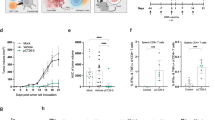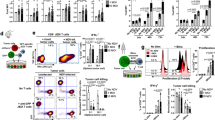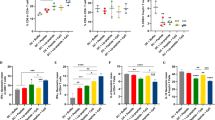Abstract
One of the major obstacles in human epidermal growth factor receptor (HER)-2/neu-specific trastuzumab immunotherapy of HER2/neu-positive breast cancer is the development of trastuzumab resistance, warranting the search for other therapeutic strategies. Although dendritic cell (DC) vaccines have been extensively applied in clinical trials for cancer treatment, the vaccination efficacy is still limited, mostly because DC vaccines are not sufficient to break tumor-associated antigen-specific self-immune tolerance in cancer patients. P30 (FNNFTVSFWLRVPKVSASHLE) derived from tetanus toxin is a universally potent CD4+ T helper epitope capable of enhancing CD8+ cytotoxic T-lymphocyte (CTL) responses. In this study, we constructed two recombinant adenoviral vectors (AdVs), AdVOVA-P30 and AdVHER2/neu-P30, expressing ovalbumin (OVA)-P30 and HER2/neu-P30. In order to enhance DC vaccine efficacy, we transfected mouse bone marrow (BM)-derived DCs with AdVOVA-P30 and AdVHER2/neu-P30 to generate engineered DCOVA-P30 and DCHER2/neu-P30 vaccines, respectively. We, then, compared CD4+ and CD8+ T-cell responses and antitumor immunity derived from DCOVA-P30 and DCHER2/neu-P30 vaccination in wild-type C57BL/6 and transgenic FVBneuN mice, respectively. We demonstrate that engineered DCOVA-P30 vaccine stimulates more efficient CD4+ and CD8+ T-cell responses than DCOVA in C57BL/6 mice. Interestingly, the increased DCOVA-P30-induced CTL responses are mainly contributed by enhanced CD4+ T-cell-stimulated CTL proliferation. We show that DCOVA-P30 vaccine also stimulates more efficient therapeutic immunity against OVA-expressing BL6-10OVA melanoma than DCOVA in C57BL/6 mice. In addition, we demonstrate that DCHER2/neu-P30 vaccine stimulates more efficient CD4+ and CD8+ T-cell responses and protective immunity against HER2/neu-expressing Tg1-1 breast cancer than DCHER2/neu in transgenic FVBneuN mice with HER2/neu-specific self-immune tolerance. Therefore, the engineered DCHER2/neu-P30 vaccine may provide a new immunotherapy alternative for women with HER2/neu+ breast cancer, especially for trastuzumab-resistant HER2/neu+ breast cancer patients.
This is a preview of subscription content, access via your institution
Access options
Subscribe to this journal
Receive 12 print issues and online access
$259.00 per year
only $21.58 per issue
Buy this article
- Purchase on Springer Link
- Instant access to full article PDF
Prices may be subject to local taxes which are calculated during checkout





Similar content being viewed by others
References
Schechter AL, Hung MC, Vaidyanathan L, Weinberg RA, Yang-Feng TL, Francke U et al. The neu gene: an erbB-homologous gene distinct from and unlinked to the gene encoding the EGF receptor. Science 1985; 229: 976–978.
Slamon DJ, Godolphin W, Jones LA, Holt JA, Wong SG, Keith DE et al. Studies of the HER-2/neu proto-oncogene in human breast and ovarian cancer. Science 1989; 244: 707–712.
Bargmann CI, Hung MC, Weinberg RA . The neu oncogene encodes an epidermal growth factor receptor-related protein. Nature 1986; 319: 226–230.
Pupa SM, Menard S, Andreola S, Colnaghi MI . Antibody response against the c-erbB-2 oncoprotein in breast carcinoma patients. Cancer Res 1993; 53: 5864–5866.
Disis ML, Knutson KL, Schiffman K, Rinn K, McNeel DG . Pre-existent immunity to the HER-2/neu oncogenic protein in patients with HER-2/neu overexpressing breast and ovarian cancer. Breast Cancer Res Treat 2000; 62: 245–252.
Peoples GE, Goedegebuure PS, Smith R, Linehan DC, Yoshino I, Eberlein TJ . Breast and ovarian cancer-specific cytotoxic T lymphocytes recognize the same HER2/neu-derived peptide. Proc Natl Acad Sci USA 1995; 92: 432–436.
Slamon DJ, Clark GM, Wong SG, Levin WJ, Ullrich A, McGuire WL . Human breast cancer: correlation of relapse and survival with amplification of the HER-2/neu oncogene. Science 1987; 235: 177–182.
Gonzalez-Angulo AM, Hortobagyi GN, Esteva FJ . Adjuvant therapy with trastuzumab for HER-2/neu-positive breast cancer. Oncologist 2006; 11: 857–867.
Sumoza-Toledo A, Eaton AD, Sarukhan A . Regulatory T cells inhibit protein kinase C theta recruitment to the immune synapse of naive T cells with the same antigen specificity. J Immunol 2006; 176: 5779–5787.
Nahta R, Esteva FJ . Herceptin: mechanisms of action and resistance. Cancer Lett 2006; 232: 123–138.
Berns K, Horlings HM, Hennessy BT, Madiredjo M, Hijmans EM, Beelen K et al. A functional genetic approach identifies the PI3K pathway as a major determinant of trastuzumab resistance in breast cancer. Cancer Cell 2007; 12: 395–402.
Nahta R, Esteva FJ . HER2 therapy: molecular mechanisms of trastuzumab resistance. Breast Cancer Res 2006; 8: 215.
Ho WY, Yee C, Greenberg PD . Adoptive therapy with CD8(+) T cells: it may get by with a little help from its friends. J Clin Invest 2002; 110: 1415–1417.
Lara-Tejero M, Pamer EG . T cell responses to Listeria monocytogenes. Curr Opin Microbiol 2004; 7: 45–50.
Wherry EJ, Ahmed R . Memory CD8 T-cell differentiation during viral infection. J Virol 2004; 78: 5535–5545.
Berzofsky JA, Terabe M, Oh S, Belyakov IM, Ahlers JD, Janik JE et al. Progress on new vaccine strategies for the immunotherapy and prevention of cancer. J Clin Invest 2004; 113: 1515–1525.
Serbina N, Pamer EG . Quantitative studies of CD8+ T-cell responses during microbial infection. Curr Opin Immunol 2003; 15: 436–442.
Sun JC, Bevan MJ . Defective CD8 T cell memory following acute infection without CD4 T cell help. Science 2003; 300: 339–342.
Sun JC, Williams MA, Bevan MJ . CD4+ T cells are required for the maintenance, not programming, of memory CD8+ T cells after acute infection. Nat Immunol 2004; 5: 927–933.
Ahlers JD, Belyakov IM, Thomas EK, Berzofsky JA . High-affinity T helper epitope induces complementary helper and APC polarization, increased CTL, and protection against viral infection. J Clin Invest 2001; 108: 1677–1685.
Renard V, Sonderbye L, Ebbehoj K, Rasmussen PB, Gregorius K, Gottschalk T et al. HER-2 DNA and protein vaccines containing potent Th cell epitopes induce distinct protective and therapeutic antitumor responses in HER-2 transgenic mice. J Immunol 2003; 171: 1588–1595.
Steinaa L, Rasmussen PB, Wegener AM, Sonderbye L, Leach DR, Rygaard J et al. Linked foreign T-cell help activates self-reactive CTL and inhibits tumor growth. J Immunol 2005; 175: 329–334.
Palucka K, Ueno H, Banchereau J . Recent developments in cancer vaccines. J Immunol 186: 1325–1331.
Melief CJ . Cancer immunotherapy by dendritic cells. Immunity 2008; 29: 372–383.
Galluzzi L, Senovilla L, Vacchelli E, Eggermont A, Fridman WH, Galon J et al. Trial watch: Dendritic cell-based interventions for cancer therapy. Oncoimmunology 2012; 1: 1111–1134.
Sotomayor EM, Borrello I, Tubb E, Rattis FM, Bien H, Lu Z et al. Conversion of tumor-specific CD4+ T-cell tolerance to T-cell priming through in vivo ligation of CD40. Nat Med 1999; 5: 780–787.
Zhou G, Lu Z, McCadden JD, Levitsky HI, Marson AL . Reciprocal changes in tumor antigenicity and antigen-specific T cell function during tumor progression. J Exp Med 2004; 200: 1581–1592.
Horna P, Cuenca A, Cheng F, Brayer J, Wang HW, Borrello I et al. In vivo disruption of tolerogenic cross-presentation mechanisms uncovers an effective T-cell activation by B-cell lymphomas leading to antitumor immunity. Blood 2006; 107: 2871–2878.
Rabinovich GA, Gabrilovich D, Sotomayor EM . Immunosuppressive strategies that are mediated by tumor cells. Annu Rev Immunol 2007; 25: 267–296.
de Jong A, van Poelgeest MI, van der Hulst JM, Drijfhout JW, Fleuren GJ, Melief CJ et al. Human papillomavirus type 16-positive cervical cancer is associated with impaired CD4+ T-cell immunity against early antigens E2 and E6. Cancer Res 2004; 64: 5449–5455.
Tassi E, Gavazzi F, Albarello L, Senyukov V, Longhi R, Dellabona P et al. Carcinoembryonic antigen-specific but not antiviral CD4+ T cell immunity is impaired in pancreatic carcinoma patients. J Immunol 2008; 181: 6595–6603.
Novy P, Quigley M, Huang X, Yang Y . CD4 T cells are required for CD8 T cell survival during both primary and memory recall responses. J Immunol 2007; 179: 8243–8251.
Bourgeois C, Rocha B, Tanchot C . A role for CD40 expression on CD8+ T cells in the generation of CD8+ T cell memory. Science 2002; 297: 2060–2063.
Janssen EM, Droin NM, Lemmens EE, Pinkoski MJ, Bensinger SJ, Ehst BD et al. CD4+ T-cell help controls CD8+ T-cell memory via TRAIL-mediated activation-induced cell death. Nature 2005; 434: 88–93.
Janssen EM, Lemmens EE, Wolfe T, Christen U, von Herrath MG, Schoenberger SP . CD4+ T cells are required for secondary expansion and memory in CD8+ T lymphocytes. Nature 2003; 421: 852–856.
Umeshappa CS, Xiang J . Regulators of T-cell memory generation: TCR signals versus CD4+ help? Immunol Cell Biol 2011; 89: 578–580.
Chan T, Sami A, El-Gayed A, Guo X, Xiang J . HER-2/neu-gene engineered dendritic cell vaccine stimulates stronger HER-2/neu-specific immune responses compared to DNA vaccination. Gene Ther 2006; 13: 1391–1402.
Sas S, Chan T, Sami A, El-Gayed A, Xiang J . Vaccination of fiber-modified adenovirus-transfected dendritic cells to express HER-2/neu stimulates efficient HER-2/neu-specific humoral and CTL responses and reduces breast carcinogenesis in transgenic mice. Cancer Gene Ther 2008; 15: 655–666.
Ahmed KA, Wang L, Munegowda MA, Mulligan SJ, Gordon JR, Griebel P et al. Direct in vivo evidence of CD4+ T cell requirement for CTL response and memory via pMHC-I targeting and CD40L signaling. J Leukoc Biol 2012; 92: 289–300.
Umeshappa CS, Huang H, Xie Y, Wei Y, Mulligan SJ, Deng Y et al. CD4+ Th-APC with acquired peptide/MHC class I and II complexes stimulate type 1 helper CD4+ and central memory CD8+ T cell responses. J Immunol 2009; 182: 193–206.
Chen Y, Xie Y, Chan T, Sami A, Ahmed S, Liu Q et al. Adjuvant effect of HER-2/neu-specific adenoviral vector stimulating CD8(+) T and natural killer cell responses on anti-HER-2/neu antibody therapy for well-established breast tumors in HER-2/neu transgenic mice. Cancer Gene Ther 2011; 18: 489–499.
Xiang J, Huang H, Liu Y . A new dynamic model of CD8+ T effector cell responses via CD4+ T helper-antigen-presenting cells. J Immunol 2005; 174: 7497–7505.
Panina-Bordignon P, Tan A, Termijtelen A, Demotz S, Corradin G, Lanzavecchia A . Universally immunogenic T cell epitopes: promiscuous binding to human MHC class II and promiscuous recognition by T cells. Eur J Immunol 1989; 19: 2237–2242.
Guy CT, Webster MA, Schaller M, Parsons TJ, Cardiff RD, Muller WJ . Expression of the neu protooncogene in the mammary epithelium of transgenic mice induces metastatic disease. Proc Natl Acad Sci USA 1992; 89: 10578–10582.
Reilly RT, Gottlieb MB, Ercolini AM, Machiels JP, Kane CE, Okoye FI et al. HER-2/neu is a tumor rejection target in tolerized HER-2/neu transgenic mice. Cancer Res 2000; 60: 3569–3576.
Bergelson JM, Cuningham JA, Droguett G, Kurt-Jones EA, Krithivas A, Hong JS et al. Isolation of a common receptor for Coxsackie B viruses and adenoviruses 2 and 5. Science 1997; 275: 1320–1323.
Wickham TJ, Mathias P, Cheresh DA, Nemerow GR . Integrins alpha v beta 3 and alpha v beta 5 promote adenovirus internalization but not virus attachment. Cell 1993; 73: 309–319.
Nemerow GR . Cell receptors involved in adenovirus entry. Virology 2000; 274: 1–4.
Huang S, Endo RI, Nemerow GR . Upregulation of integrins alpha v beta 3 and alpha v beta 5 on human monocytes and T lymphocytes facilitates adenovirus-mediated gene delivery. J Viol 1995; 69: 2257–2263.
Huang S, Kamata T, Takada Y, Ruggeri ZM, Nemerow GR . Adenovirus interaction with distinct integrins mediates separate events in cell entry and gene delivery to hematopoietic cells. J Viol 1996; 70: 4502–4508.
Okada N, Massunaga Y, Okada Y, Iiyama S, Mori N, Tsuda T et al. Gene transduction efficiency and maturation status in mouse bone marrow-derived dendritic cells infected with conventional or RGD fibre-mutant adenovirus vectors. Cancer Gene Ther 2003; 10: 421–431.
Okada N, Saito T, Masunaga Y, Tsukada Y, Nakagawa S, Mizuguchi H et al. Efficient antigen gene transduction using Arg-Gly-Asp fibre-mutant adenovirus vectors can potentiate antitumor vaccine efficacy and maturation of murine dendritic cells. Cancer Res 2001; 61: 7913–7919.
Lappin MB, Weiss JM, Delattre V, Mai H, Dittmar C, Maier K et al. Analysis of mouse dendritic cells migration in vivo upon subcutaneous and intravenous injection. Immunology 1999; 98: 181–188.
Eggert AA, Schreurs MW, Boerman OC, Oyen WJ, de Boer AJ, Punt CJ et al. Biodistribution and vaccine efficiency of murine dendritic cells after injection in patients with metastatic malignancies. Cancer Res 1999; 59: 3340–3345.
Okada N, Tsujino M, Hagiwara Y, Tada A, Tamura Y, Mori K et al. Administration route-dependent vaccine efficiency of murine dendritic cells pulsed with antigens. Br J Cancer 2001; 84: 1564–1570.
Mullins DW, Sheasley SL, Ream RM, Bullock TN, Fu YX, Engelhard VH . Route of immunization with peptide-pulsed dendritic cells controls the distribution of memory and effector T cells in lymphoid tissues and determines the pattern of regional tumor control. J Exp Med 2003; 198: 1023–1034.
Huck SP, Tang SC, Andrew KA, Yang J, Harper JL, Ronchese F . Activation and route of administration both determine the ability of bone marrow-derived dendritic cells to accumulate in secondary lymphoid organs and prime CD8+ T cells against tumors. Cancer Immunol Immunother 2008; 57: 63–71.
Wang L, Xie Y, Ahmed K, Ahmed S, Sami A, Chibbar R et al. Exosomal pMHC-I complex targets T cell-based vaccine to directly stimulate CTL responses leading to antitumor immunity in transgenic FVBneuN and HLA-A2/HER2 mice and eradicating trastuzumab-resistant tumor in athymic nude mice. Breast Cancer Res Treat 2013; 140: 273–284.
Acknowledgements
This study was supported by research grants from Canadian Breast Cancer Foundation (no. 406991), Saskatchewan Cancer Agency (no. 414138) and Canadian Institute of Health Research (MOP 89713). YX was supported by Postdoctoral Fellowship of Saskatchewan Cancer Agency.
Author information
Authors and Affiliations
Corresponding author
Ethics declarations
Competing interests
The authors declare no conflict of interest.
Rights and permissions
About this article
Cite this article
Xie, Y., Chen, Y., Ahmed, K. et al. Potent CD4+ T-cell epitope P30 enhances HER2/neu-engineered dendritic cell-induced immunity against Tg1-1 breast cancer in transgenic FVBneuN mice by enhanced CD4+ T-cell-stimulated CTL responses. Cancer Gene Ther 20, 590–598 (2013). https://doi.org/10.1038/cgt.2013.60
Received:
Revised:
Accepted:
Published:
Issue Date:
DOI: https://doi.org/10.1038/cgt.2013.60
Keywords
This article is cited by
-
HER2-Positive Breast Cancer Immunotherapy: A Focus on Vaccine Development
Archivum Immunologiae et Therapiae Experimentalis (2020)
-
Prediction and identification of HLA-A*0201-restricted epitopes from leukemia-associated protein MLAA-22 which elicit cytotoxic T lymphocytes
Medical Oncology (2014)



